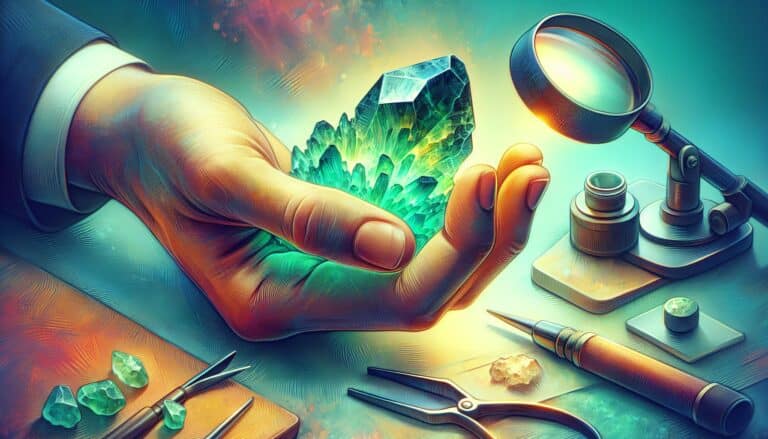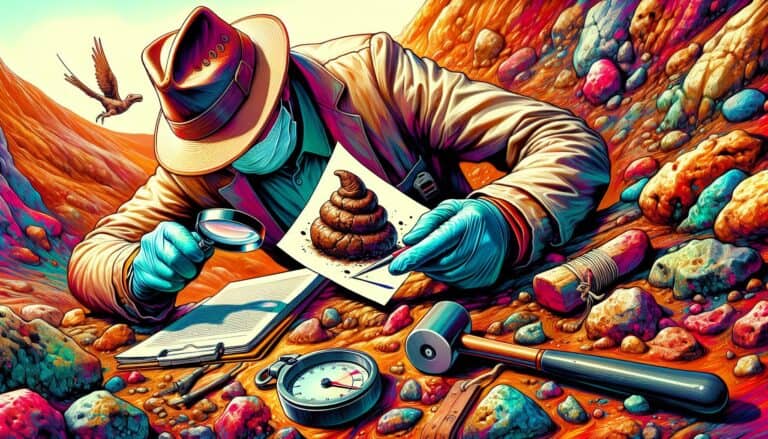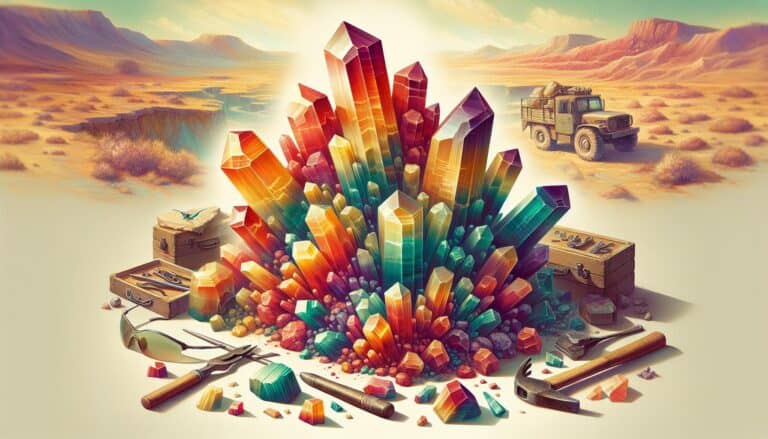Ever wondered about the value of those shimmering crystals you’ve seen at markets or in jewelry stores?
You’re not alone. Determining a crystal’s worth can be as complex as the intricate structures they bear. From amethyst to zircon, the world of crystals is vast and varied, with values that can range from a few dollars to thousands.
You might think size and sparkle are the main factors in a crystal’s value, but there’s much more to it. Rarity, origin, and even color play crucial roles in defining a crystal’s price tag.
Whether you’re a collector, a healer, or just curious, understanding what makes each crystal unique is key to appreciating their true worth.
Crystals’ value is influenced by rarity, color, clarity, cut quality, and market demand. Rarer, clearer, and uniquely colored crystals are more valuable. Fashion, wellness, and design trends also affect their price. Prices vary across types, with some like Blue Diamond and Red Beryl being particularly valuable due to uniqueness.
What Is Crystals?
Crystals are solid materials where the atoms are arranged in highly ordered, repeating patterns extending in all three spatial dimensions. These geometric patterns give crystals their hallmark symmetry and unique physical properties, like refractive index and hardness. You might be familiar with some common types of crystals, such as quartz, amethyst, and turquoise.
The process of crystal formation, or crystallization, can occur from the cooling of molten rock, as with quartz, or from the evaporation of water, like with halite. The variety of formation methods contributes to the distinctiveness of each crystal species. For example, bismuth crystals are famous for their stair-step like growth pattern and iridescent surface caused by oxidation.
Mineralogical attributes play a crucial role in identifying and valuing crystals. Experts use features like cleavage, which is how a crystal breaks, and luster, the way it reflects light, to classify and appraise them. Some crystals exhibit fluorescence or phosphorescence, emitting light when exposed to certain wavelengths, adding another layer to their appeal and price.
Beyond their physical attributes, crystals have a cultural and metaphysical significance, which sometimes inflates their value. Certain crystals are believed to promote healing, provide protection, or bring good fortune, and these beliefs can boost demand and affect how much crystals are worth.
Among gemstone enthusiasts and collectors, the provenance or source of a crystal can greatly affect its market value. Crystals obtained from legendary mines or historical sites, for instance, are often more prized. Provenance proves to be particularly important when the history attached to a crystal includes ownership by celebrities or ancient royalty.
To truly grasp the value of crystals, you need to look beyond their appearance. Digging into the intricate details of their formation, rare features, and storied past can unveil the richer story of each piece. These factors can influence both the monetary worth and the intangible value that so many enthusiasts seek.
Crystals Prices: Factors That Affect Value

Color, Clarity, and Cut Quality
When you’re exploring the worth of crystals, color is a pivotal component. Vibrant hues and rare colors often command higher prices. Take, for example, amethyst; deeper shades of purple typically reflect a higher value than lighter ones. Clarity is just as crucial; crystals with fewer inclusions — internal features or imperfections — can be deemed more desirable and hence, pricier. Transparency can also be a deciding factor, with clearer crystals fetching a premium.
As for cut quality, the skill with which a crystal is shaped and polished can heavily influence its price. A well-executed cut not only enhances the crystal’s aesthetic appeal but also its ability to reflect light, making it more attractive to collectors and enthusiasts. It’s not just about symmetry; a cutter’s expertise in maximizing the stone’s inherent beauty is what sets apart the common from the exceptional.
Market Demand and Availability
Market trends significantly affect crystals’ value. High demand paired with scarcity often inflates prices. For instance, when a particular crystal becomes popular in the fashion or wellness industries, its value typically skyrockets. On the flip side, if the market is flooded with a certain type of crystal, its price might plummet due to oversupply. Authenticity plays a role here, too—natural crystals that haven’t been treated carry more worth than those that have been artificially enhanced or replicated.
Availability, dictated by how readily a type of crystal can be mined or collected, can turn an otherwise ordinary mineral into a sought-after treasure. Limited-edition or crystals from a location of historical significance add to the scarcity, thus driving up the value. Also, consider that geopolitical issues can impact extraction and export, making certain crystals less attainable and more valuable over time.
In understanding crystal values, remember that they’re not just commodities; they carry stories, histories, and the labor of the artisans who bring them to life. With each crystal’s unique journey from earth to market, its worth is as multifaceted as its natural form.
Understanding Crystals: A Rare Gem

The Rarity of Crystals
When you’re gauging the value of crystals, one of the foremost attributes you’ll want to consider is rarity. Rarity has a direct correlation with a crystal’s value; the harder a crystal is to find, the more desirable it becomes. For instance, diamonds are particularly valuable not only because of their brilliance but also because of the incredible conditions under which they are formed. It’s the combination of these conditions and their limited existence in accessible locations that makes them so sought after.
Factors that affect a crystal’s rarity include:
- Geographical exclusivity: Some crystals are found only in certain parts of the world.
- Mining difficulty: The more labor-intensive it is to extract a crystal, the rarer it is.
- Size and Weight: Larger crystals of exceptional quality are exceedingly rare and, as a result, more valuable.
Understanding the rarity of a crystal will provide you with insight into why some crystals are priced higher than others. When rarity intersects with demand, you’ll see significant price hikes, underscoring the importance of scarcity in the valuation process.
Origins and Characteristics
The origins of a crystal play a pivotal role in determining its worth. The geographic origin can influence a crystal’s properties and color, leading to unique variations that affect its value. For example, sapphires from Kashmir are renowned for their vivid blue color and velvety texture, distinguishing them from those found in other locales.
Here’s what you need to know about the origin and characteristics:
- Trace Elements: Elements like iron, chromium, or vanadium can cause distinct color variations and add to a crystal’s uniqueness and value.
- Formation Processes: The way a crystal is formed – whether through metamorphic, igneous, or sedimentary processes – contributes to its overall character.
- Historical Significance: Crystals from locations with a rich history or story add a layer of value beyond their physical attributes.
Being aware of a crystal’s origin and the characteristics that stem from it will give you a better appreciation of its unique story and the factors contributing to its valuation. Keep in mind that while physical characteristics are quantifiable, the journey of a crystal from the depths of the Earth to your hands adds an intangible worth that’s just as influential in its valuation.
Crystals Grading and Valuation
The Grading System for Crystals
When you’re exploring the world of crystal investing, you’ll soon discover that, similar to diamonds, crystals are subject to a grading system. This grading system evaluates numerous qualities such as clarity, cut, color, and carat weight—the four Cs you’re likely familiar with in diamond grading. These factors are meticulously appraised to determine a crystal’s aesthetic and monetary value.
For clarity, graders look for Absence of Inclusions—internal imperfections. A crystal with fewer inclusions is more valuable. The cut of a crystal doesn’t just pertain to its shape but also how well it’s crafted to enhance luster and reflection. The color needs to be vibrant and uniform, with rare colors fetching higher prices. Carat weight measures a crystal’s size and density—larger specimens typically command higher values.
Certification and Appraisal
To establish a crystal’s authenticity and quality, certification and appraisal are vital steps. These processes offer you proof of the crystal’s value and ensure that you’re making a sound investment. Certification involves a detailed analysis by a Licensed Gemologist who will issue a report on the crystal’s grade based on the aforementioned criteria.
During an appraisal, a qualified appraiser will inspect the crystal’s Market Value. This not only considers the crystal’s physical attributes but also takes into account its provenance, which can significantly influence its worth. For insurance purposes, you need a certified appraisal document that states your crystal’s estimated retail replacement value. Keep in mind that market demand, and rarity also fluctuate, potentially impacting the crystal’s current and future value. With the proper documentation, you’re better positioned to negotiate sales, ensure insurance coverage, and understand your crystal’s place within the market.
Remember, an experienced appraiser will also recognize the intangible worth that accompanies a crystal’s journey from its natural setting to your collection, which factors into the overall valuation.
Current Market Trends in Crystals Pricing
Exploring the latest in market dynamics, crystal prices are heavily influenced by trends in holistic and alternative health, as well as by the popularity of specific stones. Mindfulness and well-being have become paramount in recent years, increasing the demand for crystals used in healing and meditation. Amethyst, known for its purported calming properties, and rose quartz, associated with love and emotion, are particularly sought after for these purposes.
The use of crystals in interior design has also surged, affecting pricing. Large, aesthetic pieces like geodes and crystal clusters have become statement pieces in homes and commercial spaces. This shift not only reflects the beauty of these natural formations but also hints at the belief in their energy-altering abilities.
With the rise of social media, influencers and celebrities showcasing their crystal collections have spawned a wave of interest among followers. Limited-edition finds or stones featured by high-profile individuals can experience a temporary spike in value due to this increased visibility and perceived rarity.
The table below shows a snapshot of average price ranges for some common crystals influenced by the current market:
| Crystal Type | Average Price Range |
|---|---|
| Clear Quartz | $1 – $100 |
| Amethyst | $10 – $300 |
| Rose Quartz | $5 – $150 |
| Smoky Quartz | $10 – $100 |
| Citrine | $15 – $200 |
Investment in rare crystals has emerged as a parallel to the art market. Enthusiasts and collectors are not only seeking out specimens for their beauty but also for their potential long-term value appreciation. Rarity and uniqueness can catapult prices, and in this realm, provenance or the story behind a stone plays a significant role. Auction houses have begun to feature notable crystals, validating the interest in these precious stones as worthy of investment.
Whether you’re a holistic enthusiast or an avid collector, staying abreast of these trends will guide you in making informed decisions and potentially fruitful investments in the vibrant world of crystals.
The Most Expensive Crystals
When you dive into the dazzling world of crystals, you’ll quickly realize that certain varieties command sky-high prices due to their rarity and beauty. High-end collectors and aficionados are often willing to pay a premium for these select stones. Take the Blue Diamond, for example; its exceptional hue and scarcity make it one of the most coveted and expensive crystals on the market.
Aside from the popular and pricey diamonds, some other crystals, such as Musgravite and Red Beryl, also fetch staggeringly high prices. Musgravite, similar in appearance to Taaffeite, is treasured for its unique combination of colors and extreme rarity. Meanwhile, Red Beryl, often referred to as Scarlet Emerald, is found in only a handful of locations around the world, making it a collector’s gem and worth a small fortune per carat.
Here are some top contenders for the world’s most expensive crystals:
- Blue Diamond: Valued for its mesmerizing color and clarity
- Musgravite: Sought after for its rarity and fascinating appearance
- Red Beryl: Prized for being rarer than diamonds with its unique red hue
Adventurous investors and crystal enthusiasts are also turning their attention towards other valuable stones like Jadeite and Alexandrite. Renowned for its rich green color and cultural significance, Jadeite stands as a symbol of status and luxury in several Asian cultures. Similarly, Alexandrite wows with its color-changing ability, shifting from bluish-green in daylight to purplish-red under incandescent light, making it highly prized among collectors.
Prices for these crystals can vary greatly based on the Four Cs — clarity, cut, color, and carat weight — with high-grade specimens reaching into the millions. It’s evident that as the demand for unique and high-quality crystals grows, so does their value. Keeping an eye on the shifts in the crystal market can provide insights into which of these precious stones might be an astute addition to your collection or even a wise investment choice.
Buying Crystals: Tips and Recommendations
Where to Purchase High-Quality Crystals
When you’re looking to add to your crystal collection, selecting the right place to purchase high-quality crystals is crucial. You’ll want to explore reputable dealers who are known for their exceptional products and customer service. Here are some venues you should consider:
- Specialty Crystal Shops: Often run by enthusiasts and experts, these stores can provide invaluable insights and a curated selection.
- Gem Shows: These events gather a multitude of vendors and are perfect for seeing a wide variety of crystals up close.
- Online Marketplaces: Websites like Etsy and eBay feature numerous sellers but require diligence—read reviews and verify seller credibility.
- Local Markets: Sometimes overlooked, local artisanal markets can be a treasure trove for unique finds.
Always do your homework before making a purchase. Seek out sellers who can provide detailed information about the provenance and characteristics of their crystals.
Ensuring Authenticity and Value
Your investment in crystals hinges on their authenticity and inherent value. To make savvy decisions, here’s what you need to keep in mind:
- Certificates of Authenticity: Ask for certificates or documentation that confirms the crystal’s legitimacy.
- Appraisals: Getting an appraisal from a third party can assure you of a crystal’s worth and authenticity.
- Quality Checks: Perform your own examination for common flaws or treatments that may affect value.
- Knowledge Upkeep: Stay informed about the latest news in the crystal market to understand pricing trends.
Remember, the more you know about what contributes to a crystal’s value, the better you’ll be able to judge whether a seller’s offer is fair or not. Trustworthy dealers should not hesitate to provide you with all the information you need to make an educated purchase, ensuring you’re as confident in your investment as they are in their product.
Conclusion: Buying & Selling Crystals
You now understand that determining the worth of crystals isn’t straightforward. It’s a complex interplay of factors like rarity, quality, and provenance.
Remember, certification and appraisal are your best tools to unlock the true value of your pieces. Armed with knowledge about grading systems and market trends, you’re poised to navigate the crystal market with confidence. Whether you’re investing in crystals or simply indulging in their beauty, always prioritize authenticity and the story behind each stone. By doing your homework and connecting with reputable sellers, you’ll ensure your collection is as valuable as it is stunning.
Keep these insights in mind and you’ll be well-equipped to appreciate the full spectrum of what your crystals have to offer.


![Indiana Rockhounding Sites in [year]: Spots & Finds](https://observationhobbies.com/wp-content/uploads/2024/01/hO8R94wCsmRXbt2QdEYf6-768x439.jpg)



![MA Rockhounding Sites in [year]: Treasures & Gems](https://observationhobbies.com/wp-content/uploads/2024/01/XlBh-sAkYTQF12kM8lg5Z-768x439.jpg)
